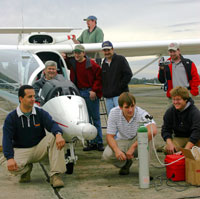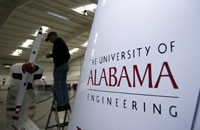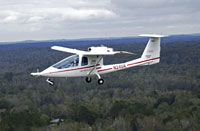Airplane Takes Engineering Researchers Aloft for Climate Change Investigations
by Mary Wymer

University of Alabama engineering researchers can now be seen high in the sky. After many years of analyzing air-quality on the ground, UA is the second university in the country operating a Sky Arrow airplane investigating global climate change causes and impacts.
UA recently unveiled the new Sky Arrow 650 Environmental Research Aircraft and introduced the Atmospheric and Environmental Research Operations Laboratory, known as AERO.
“The research possibilities with this plane are endless. From air quality and ozone issues to remote sensing and wind structure, the Sky Arrow presents many opportunities for The University of Alabama,” said Dr. Keith McDowell, vice president for research.
“The state of Alabama has many vital natural resources, such as abundant water and fertile land. It is important that The University of Alabama take the lead in conducting research that ensures we make the best use of our natural resources to benefit the state, the Southeast and the entire nation,” said McDowell.
UA’s new AERO Laboratory will focus on air quality and environmental research, including global climate change, greenhouse effects and energy exchange between the Earth’s surface and the atmosphere.
“Some of the exciting air quality research we will be able to perform using the Sky Arrow include measuring the gas and energy exchange between the Earth’s surface and the adjacent atmosphere and working with remote sensing instruments that measure ground and ocean surface properties,” said Dr. Derek Williamson, assistant professor of civil and environmental engineering and director of the AERO Program.
The information we will gather will address current gaps in the understanding of gas exchange and the variability of this surface-atmosphere transfer on climate change, said Williamson.

Williamson will work closely with research scientists from the National Oceanic and Atmospheric Administration’s Air Research Laboratory. Initial research will be conducted through the North American Carbon Program to measure carbon dioxide exchange over agricultural and forest lands. This data is a critical component to global climate change models that need carbon balance input data to track greenhouse gas concentrations and impact. The North American Carbon Program consists of nine government agencies studying the carbon cycle.
Currently, stationary towers make most carbon dioxide exchange measurements between the Earth and the atmosphere. Towers provide very accurate data over time but cover a relatively small geographic area. As needs continue to grow for continental-scale models describing the carbon cycle and climate change, satellites offer the capability to collect data over much larger geographic areas. However, the issue of scaling ground-based, tower data to data obtained from orbiting satellites is one of the major challenges to the scientific community. Small Environmental Research Aircraft, such as the Sky Arrow, will be an integral part of the effort to relate data gathered through traditional towers to that from higher altitude aircraft and satellite.

The University’s Sky Arrow is ideally suited for such studies due to its unique airframe, design, and operational characteristics, as well as its specific configuration of instruments. The Sky Arrow is ideal for environmental research because it has a rear-mounted engine that allows for the collection of uncontaminated samples through the nose probe. The aircraft’s “pusher” design consists of a rear mounted engine and propeller. This configuration also minimizes the impact of wind wash over the airframe on particular instruments.
The instruments have been designed by the National Oceanic and Atmospheric Administration, and the instrument configuration is known as the Mobile Flux Platform. These specially designed instruments are able to measure carbon dioxide, water, and energy exchange between the Earth’s surface and the atmosphere with a high degree of precision.
In addition to the current research, the AERO team will be working with NOAA on developing the next generation of instruments and sensors to enhance the capabilities of the Sky Arrow and other research platforms. These types of innovations are critical to furthering scientific discovery and collecting the necessary data to address environmental challenges.
The Sky Arrow was designed and manufactured by Iniziative Industriali Italiane S.p.A. (3I) of Rome, Italy, and it was distributed by its U.S. agent Pacific Aerosystems. The plane is capable of flying at speeds of up to 100 knots or 115 miles per hour. It is powered by a naturally-aspirated 100 horsepower engine, equipped with a fixed pitch propeller, a rectangular wing supported by two struts and a fixed landing gear.
The Sky Arrow has a Federal Aviation Administration type certification. The identification letters for the new Sky Arrow are N24UA. The University has a contract with Dixie Air Services to maintain and hanger the plane and to provide certified pilots. The plane is operated with a private pilot and a university researcher in the second seat.
Further Reading